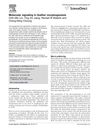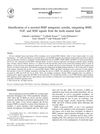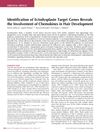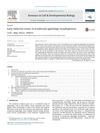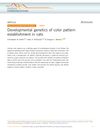Identification of Dkk4 as a Target of Eda-A1/Edar Pathway Reveals an Unexpected Role of Ectodysplasin as Inhibitor of Wnt Signaling in Ectodermal Placodes
April 2008
in “
Developmental biology
”
TLDR Ectodysplasin inhibits Wnt signaling to help form hair follicles.
The study identified dkk4 and lrp4 as direct targets of the Eda-A1/Edar pathway, revealing that ectodysplasin inhibits Wnt signaling in ectodermal placodes. Microarray and RT-PCR analyses showed significant upregulation of dkk4 and moderate upregulation of lrp4 upon Eda-A1 activation. These genes were expressed in hair, tooth, and mammary placodes, with higher expression in transgenic mice overexpressing Eda-A1. The findings suggested that Eda-A1 induces placode inhibitors, highlighting the importance of fine-tuning signaling during placode formation and proposing a model where Wnt signaling precedes Eda signaling in hair placode induction.
